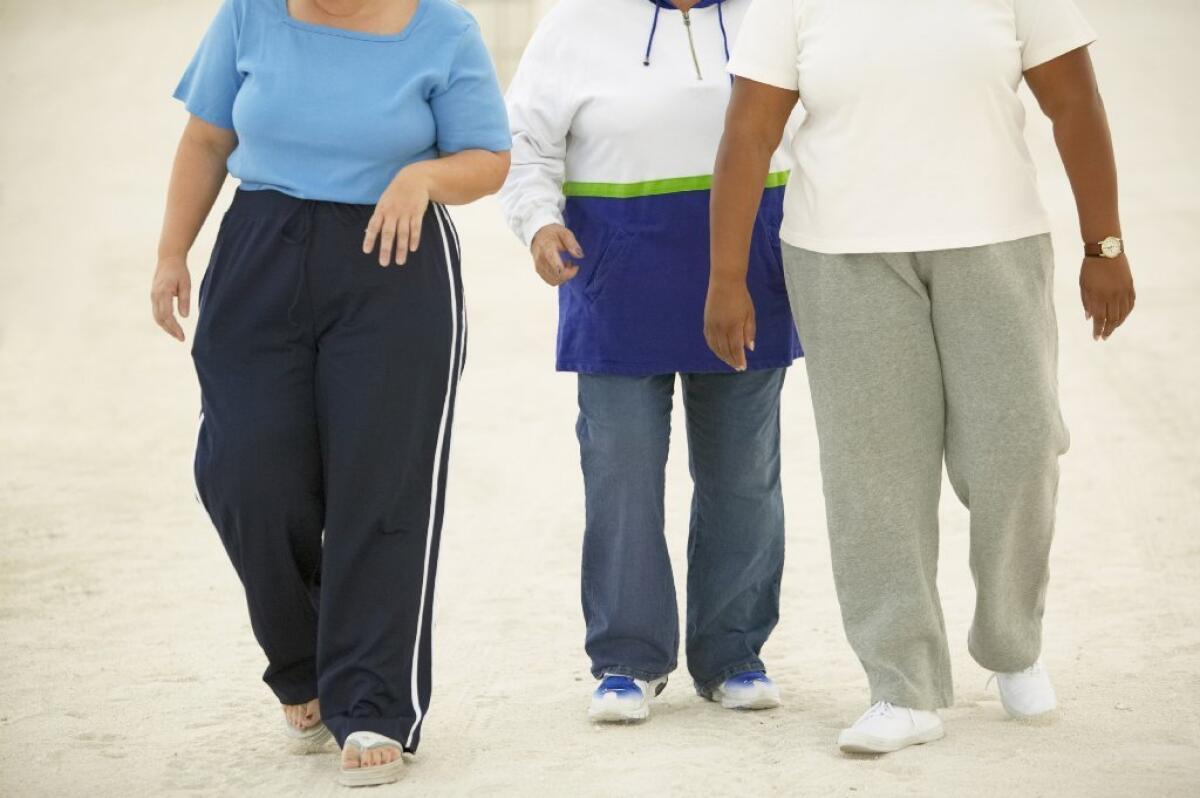Pear-shaped vs. apple trumps body mass index as a measure of risk

The risk of dying and of living with health complications may have more to do with where a person carries his or her fat than with how much fat a person carries, says a new study.
You’re carrying a spare tire around your midsection. But your body mass index hasn’t even broken the “overweight” barrier of 25, and lies well below the cut point for obesity.
No need to worry, right?
Wrong, says a new study, which has found that among adults 18 to 90 across the BMI continuum, having an apple shape increased the risk of death -- particularly death from cardiovascular disease.
Even at BMIs above 30, where obesity begins, men and women whose waist-to-hip ratio identified them as more pear-shaped were less likely to die -- of any cause and of cardiovascular causes -- than those with similar BMIs who were apple-shaped.
The new research, published online Monday in the Annals of Internal Medicine, is among the largest and most rigorous studies to tease apart the risks that comes with central obesity from those that come with being overweight or obese. To draw its conclusions, researchers gathered a study population of 15,184 adults, ages 18 to 90, who had both their BMI and waist-to-hip ratios calculated, and tracked them for 15 years to see how many died of any cause.
Men and women who were considered obese according to the BMI were more likely to die during the follow-up period than were those defined as a normal weight and those as overweight. But in every group, waist-to-hip ratio trumped BMI as a predictor of risk of death.
Obesity, as defined by BMI, has been shown to confer higher risks of a wide variety of ills, including cardiovascular disease, diabetes and cancer. But while BMI is a convenient gauge of overall fatness, researchers in recent years have complained that it is not the best predictor of the health risks that come with carrying too much fat.
In particular, many fear, it is giving false reassurance to many people who are dubbed “normal healthy weight.”
Health risks long linked to BMI, some have argued, appear to be better captured by measures, such as the waist-to-hip circumference, that reflect not only how much fat a person carries, but where he or she carries that fat. When excess fat clusters around the midsection, many have long suspected, it is more dangerous than when it is widely distributed.
Most who qualify as obese will indeed have a “waist-to-hip ratio” that spells danger. But some overweight and obese people are just big: Their fat tends to be more distributed across hips and legs, chest and arms, and less concentrated around their waist.
But many who qualify as “normal weight” also carry too much of their body weight around their waist. With slender legs, arms and rear ends, their waist circumference comes close to equaling -- and sometimes exceeds -- the greatest circumference of their buttocks.
In the new research, central obesity for men was defined as having a waist-to-hip ratio greater than 1.0 for men and .92 for women. Being pear-shaped -- being free of central obesity -- was defined as having a waist-to-hip ratio of .89 for men and .80 for women. The waist was measured at the “high point of the ileac crest,” and the hips were measured “at the greatest circumference of the buttocks.”
Mayo Clinic internal medicine specialist Dr. Francisco Lopez-Jimenez, the senior author of the study, said the new research should help physicians to better assess the risks of their patients. The BMI measure “is not really telling you the whole story in individual patients,” said Lopez-Jimenez.
A patient with a BMI over 30 certainly has obesity-related risks, Lopez-Jimenez said. But if her waist-to-hip ratio suggests she is not centrally obese, the risks he might discuss with her might focus more on mobility and quality of life than on heart disease.
If a man with a protruding belly and a BMI of 22 comes into his office, Lopez-Jimenez added, he knows now he shouldn’t miss the chance to warn that patient about cardiovascular risk and diabetes.
“Chances are this person will be very happy about the way he looks, and will feel pretty healthy because he’s skinnier than those around him. He’ll think, ‘I’m OK no matter what I eat, or how little I exercise,’” said Lopez-Jimenez. “Before this paper I would have a hard time convincing that patient he was at risk, because in a way that’s what society has been telling him. It’s a false sense of security.”
Follow me on Twitter @LATMelissaHealy and “like” Los Angeles Times Science & Health on Facebook.





